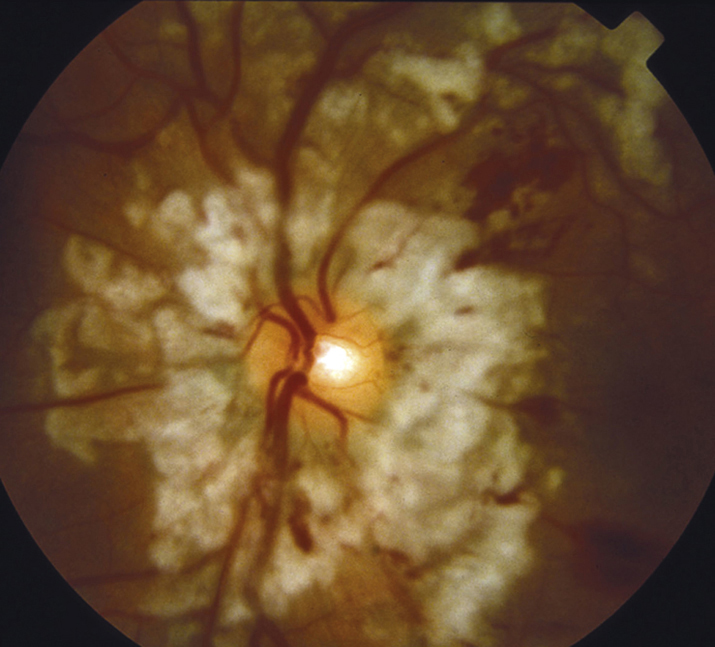Symptoms
Decreased vision, often sudden; can be severe. History of compression injury to the head, chest, or lower extremities (e.g., long bone fractures), but not a direct ocular injury.
Signs
(See Figure 3.20.1.)
Critical
Multiple cotton wool spots and/or intraretinal hemorrhages in a configuration around the optic nerve; can also have larger areas of superficial retinal whitening with perivascular clearing (Purtscher flecken). Changes are typically bilateral but may be asymmetric or unilateral.
Other
Serous macular detachment, dilated tortuous vessels, hard exudates, optic disc edema (though the disc usually appears normal), macular pseudo–cherry-red spot, RAPD, and optic atrophy when chronic.
Differential Diagnosis
- Pseudo–Purtscher retinopathy: Several entities with the same or similar presentation but not associated with trauma (Purtscher retinopathy by definition occurs with trauma), including acute pancreatitis, malignant hypertension, thrombotic thrombocytopenic purpura (TTP), hemolytic uremic syndrome (HUS), collagen vascular diseases (e.g., systemic lupus erythematosus, scleroderma, dermatomyositis, Sjögren syndrome), chronic renal failure, amniotic fluid embolism, retrobulbar anesthesia, orbital steroid injection, and alcohol use.
- Central retinal vein occlusion: Unilateral, multiple hemorrhages and cotton wool spots diffusely throughout the retina. See 11.8, CENTRAL RETINAL VEIN OCCLUSION.
- Central retinal artery occlusion: Unilateral retinal whitening with a cherry-red spot; see 11.6, CENTRAL RETINAL ARTERY OCCLUSION.
Etiology
Not well understood. It is felt that the findings are due to occlusion of small arterioles in the peripapillary retina by different particles depending on the associated systemic condition: complement activation, fibrin clots, platelet–leukocyte aggregates, or fat emboli.
Workup
- History: Compression injury to the head or chest? Long bone fracture? If no trauma, any symptoms associated with causes of pseudo–Purtscher retinopathy (see above, e.g., renal failure, rheumatologic disease)?
- Complete ocular evaluation including dilated fundus examination. Rule out direct globe injury.
- CT of the head, chest, or long bones as indicated.
- If characteristic findings occur in association with severe head or chest trauma, then the diagnosis is established and no further workup is required. Without trauma, the patient needs a systemic workup to investigate other causes (e.g., blood pressure measurement, basic metabolic panel [BMP], CBC, amylase, lipase, rheumatologic evaluation).
- Fluorescein angiography: Shows patchy capillary nonperfusion in regions of retinal whitening.
Treatment
No ocular treatment available. Must treat the underlying condition if possible to prevent further damage.
Follow Up
Repeat dilated fundus examination in 2 to 4 weeks. Retinal lesions resolve over a few weeks to months. Visual acuity may remain reduced but may return to baseline in 50% of cases.
